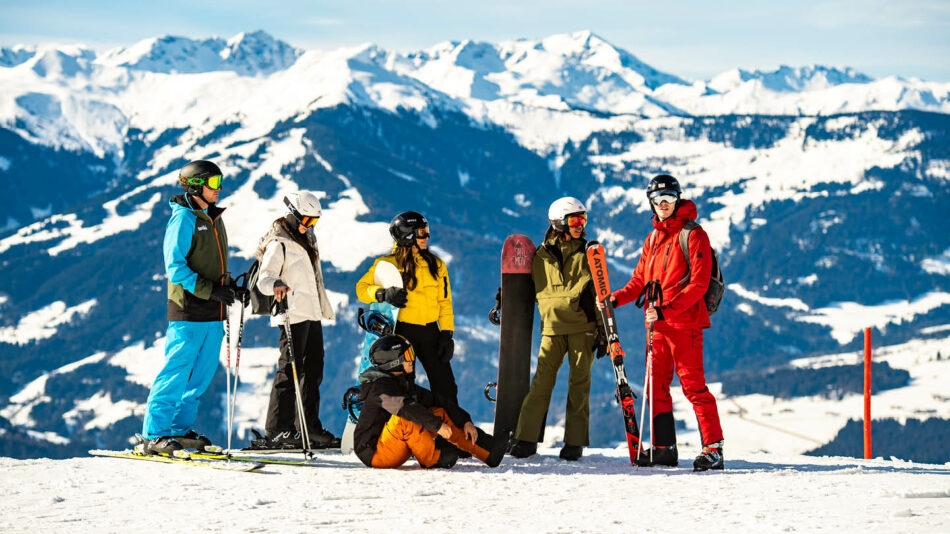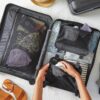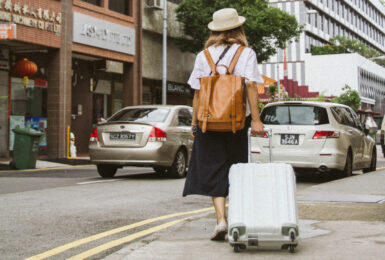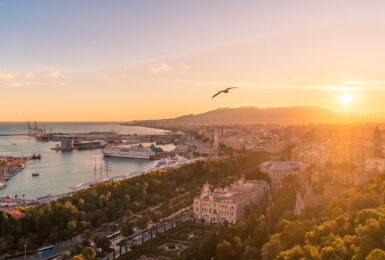
Table of Contents
- Clothes
- Clothes for Everyone
- Shoes
- Underwear and socks
- Accessories
- Sun-seekers
- Winter adventurers
- Electronics and Accessories
- Toiletries and personal items
- Documents and Money
- What should I pack for 10 days in Europe?
- What should I pack for two weeks in Europe?
- What should I pack for 30 days in Europe?
The time has almost come. The nervous anticipation. The incomparable excitement. You’re about to explore one of the world’s most diverse continents. And though you’ve read the guidebooks (or the Contiki itineraries), one question remains: what’s going to be on your Europe packing list?
Whether it’s your first, or just your latest trip that’s in the works, it never hurts to have a list of the packing essentials for Europe. Even seasoned pros have found themselves halfway around the globe and realised not a singular sock has found its way into their suitcase *cough* guilty *cough*. That’s why we have put together the Europe travel checklist to help you explore lightly (and sustainably) with all the essentials covered.
Clothes
What’s the first thing you think about when planning your Europe packing list? Clothes, right? Well don’t worry, we’ve got you covered (literally). Here are some general guidelines to keep in mind:
1. Keep it light
Now the quantity that you pack is going to vary depending on your trip, but less is more. There are launderettes in Europe and it’s best to pack light to leave some space for the awesome souvenirs you’ll be picking up along the way. There’s no shame in being an outfit repeater, if an outfit is hitting then why not wear it again?
Due to its environmental impact, we’re not big fans of fast fashion at Contiki (and we did say this would be a sustainable list). So, rather than buying millions of items of Asos for one trip that you’ll never wear again, think about high quality items that’ll have a long shelf life and that you’ll reuse for your next trip. You can read here for extra sustainable fashion tips as well.
2. Keep it simple
I am not recommending that anyone only pack monochrome clothing, but quality, versatile staples are easy to match and remove the morning struggle of assembling an outfit. They’re called staples for a reason! It can be as easy as keeping in mind the colours of your tops and bottoms when packing.
Trying to pack and wear a completely new wardrobe for ‘Europe you’ is probably going to be expensive and frustrating to actually incorporate into your day-to-day travel outfit. I can almost guarantee you’re going to regret leaving your favourite plain white tee at home. You’re still your awesome self, just in Europe.
So, bring that outfit or two with wow-factor but you have to ask yourself, if the item is not something you would wear in everyday life, how many times are you realistically going to wear it on the road?
3. Keep it seasonal
Before choosing things to pack for Europe, you first have to decide when you’ll be travelling to Europe. (If you’re still struggling with that decision, check this out). Because what you pack for Poland in winter is of course going to be very different from what you pack for your Italian summer.
The main difference between your summer and winter packing list will be layering and a few specialty items. Don’t worry, we have made extra lists for you further down the article for summer and winter travellers.

Image source:Contiki
Clothes for Everyone
THE travel fit
I am talking that one outfit that embodies comfiness. What this outfit looks like is entirely up to you but think ‘loungewear’; trackpants, leggings or shorts paired with a hoodie or a sweater.
And if you’re travelling in summer and need an extra nudge to sacrifice suitcase space on a cozy and comfy outfit, let me plead my case:
- You might be surprised at how large Europe is and that means you’ll spend a decent amount of time on the road, at train stations or in the air.
- You are going to get cold. Temperatures can drop at night and they do have AC in Europe (…okay rarely, but sometimes).
- This outfit can double as PJ’s, which you will need unless you plan on going au naturel in shared hostel rooms.
- It can double as a nice squishy pillow that you pop between your head and hard surfaces if you’re squeezing in a snooze on the move.
Something for rain
Not to ruin all of your hot girl summer dreams… but there’s a chance it’s going to rain. Bring an umbrella or light raincoat and you’ll be prepared to breeze through those summer showers and straight onto your next bucket list experience.
Swimwear
I recommend a couple of sets of swimmers for summer travellers, that way when one suit is drying you can still pop on a dry set. Winter travellers may be hesitant to bring any, but you never know when the waters are going to call your name. You won’t regret squeezing in one teensy little pair of bathers when you come across a hot tub or a thermal bath.
Tops
- 4-5 casual tops – t-shirts or singlets/vests
- 1-2 going out tops – blouses, button-ups, that sequined number you have…
- 1-2 dresses – if dresses are your thing, I could not recommend them more highly. They’re a whole outfit in one and most can be dressed up or down depending on the event.
Bottoms
- 1 pair of jeans
- 1 pair of trousers, slacks, or a smart skirt
- 2-3 pairs of shorts or skirts – for winter you can swap the shorter clothing for extra pants or jeans.
At least one pair of your jeans or trousers should be free of rips and considered ‘smart’, particularly if you are planning a trip to places with a strict dress code like the Monte Carlo Casino or the Vatican City.
Shoes
Be smart about shoes as they will suck up suitcase space very quickly. Most people only need three pairs of shoes; a pair that is comfortable to walk in all day, a pair of smarter shoes and slip-on shoes. Anything extra you can fit in is a bonus.
Comfortable shoes
What you consider an all-day comfortable shoe is up to you, but make sure whichever shoe you pick you have tried, tested and worn in. Blisters will kill the vibe instantly.
Winter travellers note that it may be wet, so it’s best to choose shoes that are water resistant to keep those little piggies nice and warm.
Smarter shoes
This is your ‘nice’ pair of shoes – loafers, boots, clean sneakers or sandals. You can enter most venues in Europe wearing a clean and smart looking pair of sneakers, but this is often at the discretion of security at each bar, club, or casino. If your sneakers err more on the side of athletic than fashionable, maybe consider bringing at least one pair of shoes that are not sneakers.
Personally, I would not recommend bringing high heels. And believe me, my fashionable traveller, I know you have that outfit planned that will only look good with heels. I have been there too. But I can promise you that my outfit did not look that good (nor did I feel that good) after having to navigate stairs and cobblestone streets, even in my most comfortable heels. If you have the space, go for it, but definitely plan to wear them for an activity with minimal walking or dancing.
Slip-on shoes
A pair of slides or thongs (also known as: jandals, flip-flops or plakkies) are easy to pop on and useful for showers, beach trips and those days where tying a shoelace is too much effort.

Image source:Contiki
Underwear and socks
Not to sound like your mum, but have you packed some spare undies? Underwear and socks are going to be the first clean thing you run out of on the road and there’s only so many times you can turn them inside out before they desperately need washing.
I can’t tell you how many socks and underwear you exactly need, but whatever number you pick, add on an extra pair or two on top of that for good measure.
For my bra wearing friends, pack a few and make sure that you prioritise comfort over looks, because nothing says sexy like a practical bra.
Top tip: I always stuff my socks in my packed shoes to save space.
Accessories
If you have packed smart and kept the clothing simple, accessories are where you get to have some fun without sacrificing luggage space. The same outfit with different accessories can easily take you from casual daywear to a dressed up evening look. Having one or two of each accessory in different colours, patterns or textures can change up a whole outfit.
- Belts
- Sunglasses
- Hats
- Hair accessories like scrunchies, headbands, watches
- Jewellry
- Handbags, purses, or totes
- Ties
- Scarves – For summer, a light scarf can be worn in your hair, on a bag to add pazazz and can even be used as a shawl for covering up in religious sites. For winter, having two different colours increases the variety of outfits you can wear.
Sun-seekers
Whether you’re going to be sailing the Croatian coastline or climbing the Spanish Steps in Rome, your packing goal is to keep it light and breezy. Linens and breathable materials are your new best friends.
Here are some more summer-specific items to pack:
- A hat
- Sunglasses
- If you know you’re going to be swimming a lot, consider bringing an extra towel to act as a ‘beach towel’ so that you aren’t using your already wet bath towel. Traditional beach towels are thick and dry slowly, so consider bringing a spare microfibre towel for swimming.
- Dresses or skirts get serious airflow and are comfortable to throw on over wet swimwear.
- Lightweight pants, you may need to cover up for religious sites or to show respect in places with different cultures.
Winter adventurers
When picking winter clothes, not all items have to be thick and chunky. Just because it is cold outside, it doesn’t mean you have to look like a marshmallow. Layering your clothing allows you to control your temperature depending on the time of day, cold exposure, and activity.
You don’t want to be a sweaty mess under your three hoodies, that’s why for layering it is best to pack breathable, moisture wicking and heat retaining materials. Laundry is also going to dry slower in winter, so lighter materials are going to dry quickest.
- Thermal leggings – 1 to 2 pairs. They are super light, barely take up luggage space and can be seamlessly worn under your other bottoms (pants or maxi skirts). I would even recommend bringing a pair if you are travelling during early spring, or late autumn, as they allow you to dress how you want but stay warm at the same time.
- Undershirts – 1 to 2. Similar to the above, a thermal or wool undershirt is going to keep you warmest. However, as it is often easier to layer your upper body, undershirts do not have to be thermal by design. I find wearing a ‘normal’ shirt under my layers usually does the trick for me.
- An ultra-light and portable down parka (folds up for portability but nice and warm, too)
- A flannel shirt is comfortable and great for layering
- 1-2 sweaters, cardigans or hoodies
- A jacket to wear over the top – The ideal all-around jacket is water-resistant, insulated and you like the look of it! Your jacket is probably going to be in all of your winter travel pics, so pick one you like but don’t sacrifice warmth or dryness for aesthetics.
- The specs you require will be up to you because travelling to Scandinavia in January is going to require a much more heavy duty jacket than Spain in February.
- Beanie
- Gloves
- Scarf
- Socks – fight the temptation to pack your thickest socks and opt for moisture wicking socks that not only keep your feet dry, but dry quickly after washing.

Image source:Contiki
Electronics and Accessories
Okay your clothes are packed, and you packed smart, so now you have space for all your other bits and bobs. But what are the things to bring to Europe that you’re actually going to use? Let’s get into it…
Phone
It seems obvious, but don’t just bring your phone (and the cord!) but also make sure it is set up for travel before you leave your home country.
Wifi is readily available most places but make sure you can access your most important information offline. Have you downloaded your tickets? How about your travel insurance information? Maybe take a photo of your passport while you’re at it too.
If you are planning on buying a European SIM card on arrival (highly recommended) you make sure that you are not relying on banking apps or other services that require text verification unless it can be updated to your new SIM.
Power bank
There is nothing worse than being lost on the streets of Rome and your phone dying. Buy one with a large capacity (they’re pretty sleek these days) and charge that bad boy up, normally they will last you a few days between charges.
Universal plug adaptor
Not sure which countries accept which plug type on your trip to Europe? Save yourself the research and get a universal adaptor that covers all the bases.
Kindle or other e-reader
This has to be one my favourite travel essentials of all time. Long gone are the days of lugging around hardbacks I picked up at the airport. 1 small device. Hundreds of poolside reads. The perfect travel companion.
Headphones
Want to pretend your life is a movie? Listening to Paris by Taylor Swift in Paris is a one way ticket to a main character moment. You can also pop these in to drown out any snorers in hostel rooms.
Earplugs
Ditto to the above, earplugs are the analogue alternative to headphones. We really don’t want you locked up abroad for murdering a snorer.
Eyemask
Another item to help you catch those Z’s. Every minute of quality sleep counts when there is so much to see during the rest of the day.
Cross body bag
A backpack makes a great day bag, but for when you’re only out and about for part of the day (or night) you’ll appreciate travelling light, especially if you’re clocking up some mileage on the d-floor! The cross body feature makes the bag more theft resistant and won’t scream I AM A TOURIST like a fanny pack will.
Tote bag
Let’s be honest, you’ll totes be shopping in places like Milan, Paris and London. So say no to single-use plastics, and bring along a tote bag that can easily be popped in your day bag. (It looks better anyway).
Water bottle
Speaking of single-use plastics, did you know that 88% of the sea’s surface is polluted by plastic waste? Water in Europe is generally incredibly clean, safe and delicious. So, yeah, bring a reusable water bottle. Think of the baby turtles, man.
Padlock
If you’re staying at a hostel when backpacking Europe, there may be lockers for your valuables. So bringing a small padlock is always a good idea.
Packing cubes
Heard of these guys? Not only do they keep everything nice and compact in your case/bag, they also are a great way to categorise your stuff on the move. When you’re scrambling on the floor of a hotel/hostel with 2 minutes until checkout, it’s nice to know where your underwear is, ya’know?

Image source:Contiki
Toiletries and personal items
The exact contents of your toiletry bag are exactly that, personal, and to be honest I don’t even know your skin-type so I can’t get into specifics. But here are some must haves for everyone:
A towel!
A microfiber one, to be precise. These lil’ beauties fold small and dry in no time at all, so you’ll be able to pack and go without a musty scent emanating from your backpack. Ideal.
Suncream
Ever heard this epic Baz Lurhmann track? He’s got a point. Keep yourself looking youthful and beautiful, and more importantly: safe. Sunscreen is an all-year round toiletry, some of the most harsh sunburns I have seen are from the sun reflecting off snow on the slopes.
Toiletry bag
It’s a good idea to fill this with little versions of your everyday essentials, so getting through airport security is a breeze. Buying small bottles, tubes and containers and decanting your everyday products into them is much more affordable than buying the travel sized versions.
Below 100ml of larger products like deodorant, perfume/aftershave, shampoo, conditioner and toothpaste is ideal.
Tissues and wet wipes
A few packs of travel tissues and a small packet of wet wipes will get you out of sticky situations…literally.
Basic medication
While they have paracetamol in Europe, save yourself the hassle of hunting down pharmacies and translating medications from Dutch to English by bringing yourself a basic first-aid kit:
- Pain relief – paracetamol and/or ibuprofen
- Band-aids – blisters happen when you least expect them
- For those rough mornings – electrolyte replacement sachets like Hydralyte
- If you get travel-sick – travel-sickness tablets or ginger tablets
- If you have a sensitive stomach – consider bringing a gut calming medication
- If you take regular medication – make sure you have it handy and enough packed for the duration of your trip

Image source:Contiki
Documents and Money
Credit cards and debit cards
While most places accept tap-and-pay phone payments, a lot of Europe still relies on cold hard cash as their preferred payment method. Bring a couple of physical credit or debit cards to withdraw cash.
Aim to bring cards from at least two different banks or accounts in case an unexpected block or issue occurs with one of the providers.
Not all travel cards and credit cards are made equal. Compare the international transaction fees before travelling so you do not end up with a shock when you see your bill.
Sort travel insurance
If you’re booking a Contiki, you can get it directly through us. Alternatively, some banks offer travel insurance to their customers under certain policies, or shop around using a comparison website.
Passport
Make sure it’s still in date and has at least 3 to 6 months before it expires. Many countries have in place laws that prevent travellers from entering with less than 3 or 6 months of validity on their passport.
Alternate ID
Passports + big nights on the town = not a good mix. For most venues in Europe you will be able to use official ID from your home country as proof of age, such as a drivers licence. By reducing the frequency you take your passport out, you reduce the chance of losing it.
Visa (if needed)
Most of Europe is part of the Schengen Zone which allows many nationalities to freely travel between 27 countries for up to 90-days. However, before you head off it is best to double check any visa requirements for where you are heading. For example, a visa is required in Turkey for most travellers.
As you can see, a fair bit of thinking goes into a Europe travel checklist.ut there’s no need to be overwhelmed!
I can safely say on my first Europe trip I didn’t think to bring at least half of the items covered in this list. The above list has been created over many trips, and many more mistakes.
We have provided guidelines on what to pack for Europe, but at the end of the day it is your holiday of lifetime so pack whatever feels right to you.
What should I pack for 10 days in Europe?
Think about the essentials for your Europe packing list. Underwear and socks for each day, a few tees, a few pairs of shorts, a pair of jeans, some nice clothes for going out, swimmers and electronics. If you can’t fit it into a carry-on, you’re doing it wrong. Less is more.
What should I pack for two weeks in Europe?
2 weeks in Europe is where checked luggage might be justified. More underwear and socks, for a start, so you’re not always scoping local laundrettes. More varieties of clothing for different temperatures. Oh, and if you’re checking luggage, you don’t have to worry about those pesky liquid limits, so go nuts with your perfumes and face creams.
What should I pack for 30 days in Europe?
Honestly, my advice is: about the same as what you’d pack for two weeks. I once travelled for 6 months in South East Asia with a single backpack, and it slowly dawned on me that I had way more stuff than I needed. Make sure you walk the line between having everything you need and not lugging heavy luggage over cobblestoned streets every few days. Trust me, it’s not worth it.
All this seem stressful? Why not download Contiki’s Pack my Bag skill and get Alexa to build your personalised, region-specific packing list?











